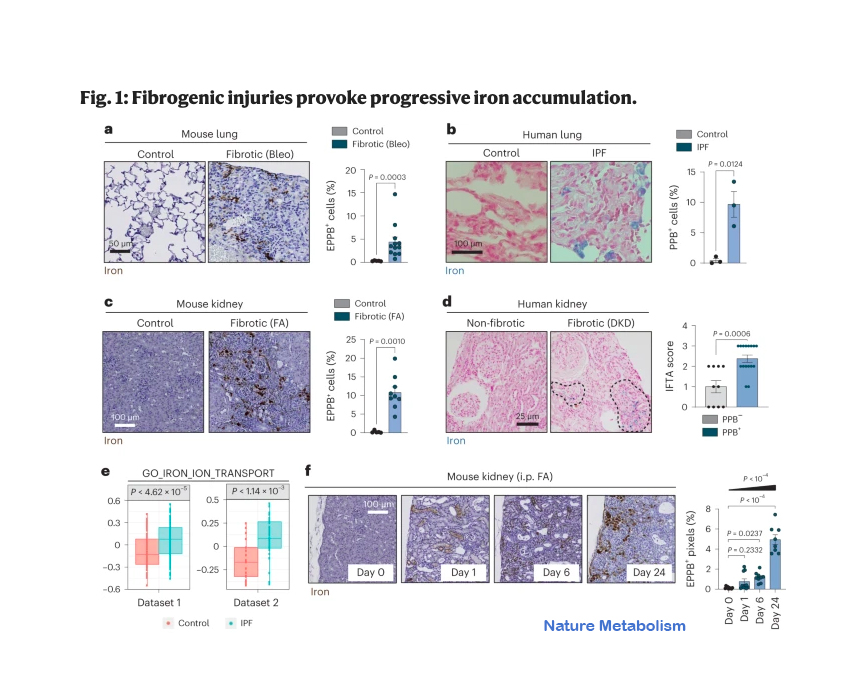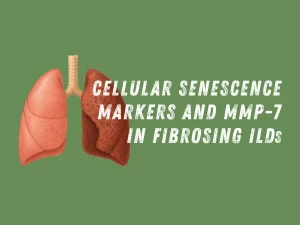Iron accumulation drives fibrosis, senescence and the senescence-associated secretory phenotype

Fibrogenesis is part of a normal protective response to tissue injury that can become irreversible and progressive, leading to fatal diseases. Senescent cells are a main driver of fibrotic diseases through their secretome, known as senescence-associated secretory phenotype (SASP). Here, we report that cellular senescence, and multiple types of fibrotic diseases in mice and humans are characterized by the accumulation of iron. We show that vascular and hemolytic injuries are efficient in triggering iron accumulation, which in turn can cause senescence and promote fibrosis. Notably, we find that senescent cells persistently accumulate iron, even when the surge of extracellular iron has subdued. Indeed, under normal conditions of extracellular iron, cells exposed to different types of senescence-inducing insults accumulate abundant ferritin-bound iron, mostly within lysosomes, and present high levels of labile iron, which fuels the generation of reactive oxygen species and the SASP. Finally, we demonstrate that detection of iron by magnetic resonance imaging might allow non-invasive assessment of fibrotic burden in the kidneys of mice and in patients with renal fibrosis. Our findings suggest that iron accumulation plays a central role in senescence and fibrosis, even when the initiating events may be independent of iron, and identify iron metabolism as a potential therapeutic target for senescence-associated diseases.
Puedes leer el artículo completo aquí: https://www.nature.com/articles/s42255-023-00928-2
Authors: Mate Maus, Vanessa López-Polo, Lidia Mateo, Miguel Lafarga, Mònica Aguilera, Eugenia De Lama, Kathleen Meyer, Anna Sola, Cecilia Lopez-Martinez, Ines López-Alonso, Marc Guasch-Piqueras, Fernanda Hernandez-Gonzalez, Selim Chaib, Miguel Rovira, Mayka Sanchez, Rosa Faner, Alvar Agusti, Rodrigo Diéguez-Hurtado, Sagrario Ortega, Anna Manonelles, Stefan Engelhardt, Freddy Monteiro, Camille Stephan-Otto Attolini, Neus Prats, Guillermo Albaiceta, Josep M. Cruzado & Manuel Serrano
Noticias relacionadas

Cellular Senescence Markers and Matrix Metalloproteinase-7 Are Co-expressed in Fibrosing Interstitial Lung Diseases
Study highlights the role of cellular senescence markers (p16, p21) and MMP-7 co-expression in fibrosing interstitial lung diseases.

Impact of Ex Vivo Lung Perfusion System on the Lung Microbiome
Discover how ex vivo lung perfusion (EVLP) impacts the lung microbiome and its implications for improving donor lung viability and reducing transplant complications.

Falling through the cracks: what happens to survivors of preterm birth?
Survivors of preterm birth face increased risks of respiratory diseases, yet awareness among specialists is low. This study examines gaps in long-term care, highlighting the need for clear follow-up guidelines and improved communication between medical teams.
Artículos
Fibrosis
- 768786·Mate Maus et al. Iron accumulation drives fibrosis, senescence and the senescence-associated secretory phenotype
- 769072·Tamara Cruz et Al. – Lung immune signatures define two groups of end-stage IPF patients
- 769275·Nuria Mendoza et al. Blood Immunophenotypes of Idiopathic Pulmonary Fibrosis: Relationship with Disease Severity and Progression
- 779185·Vincent Cottin et Al. Syndrome of Combined Pulmonary Fibrosis and Emphysema. An Official ATS/ERS/JRS/ALAT Research Statement.
- 779376·Gerard J. Criner, Alvar Agusti, Hossein Borghaei, Joseph Friedberg, Fernando J. Martinez, Curtis Miyamoto, Claus F. Vogelmeier, Bartolome R. Celli.Chronic Obstructive Pulmonary Disease and Lung Cancer: A Review for Clinicians
Recuerda que puedes acceder a varios enlaces a artículos dentro de la categoría Fibrosis en esta web. También puedes acceder otros enlaces en el Listado de Artículos de la Cátedra de Salud Respiratoria.
Imagen obtenida en artículo original.
